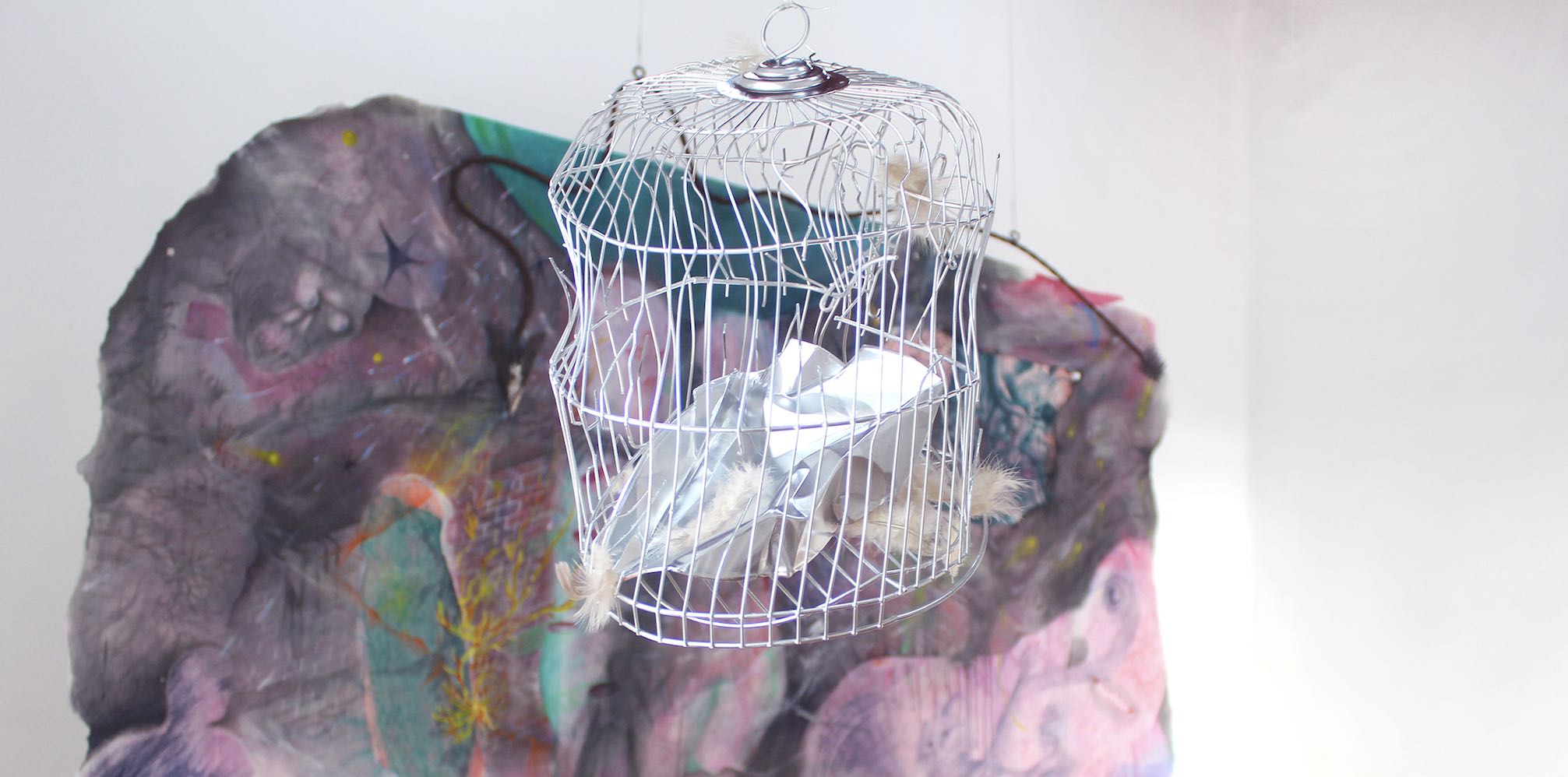
Interview
Love is Eerie: Interview with Mili Herrera
by Sofía Ortiz
Reading time
9 min
I arrive at Salón Silicón to see the exhibition. I got to know the work of Mili Herrera from one afternoon of endless scrolling on Instagram. Within the broth of memes and sexy selfies appeared some finely hatched drawings with a dark Lisa Frank palette that immediately caught my attention. I ring the doorbell and enter. The gallery consists of two well-lit rooms, wooden floors, and a hallway converted into an exhibition space with two sunbathing dogs.
Mili was late, which suited me quite well. I wanted to look at the work slowly and with the luxury of ignorance in order to project myself into what I was seeing. Because of its delicate strokes in the photos, I could not imagine that one of the pieces would be so big. The work calls for an unhurried eye; it feels simultaneous. I find it hard to focus on a primordial sensation—I jump from one character to another, seduced by images that seem to be disappearing like hot breath on glass. Then Mili explains to me that part of her process has been to erase many of the things she draws. This stacking-up of “drawing ghosts” evokes something that insists on its indeterminacy. Nevertheless, I keep looking and I begin to recognize details and characters that I can place within many different worlds: the tender, the grotesque, the clinical, the heartbreaking, among others. I imagine Mili as a Dr. Frankenstein plugging one drawing into another.
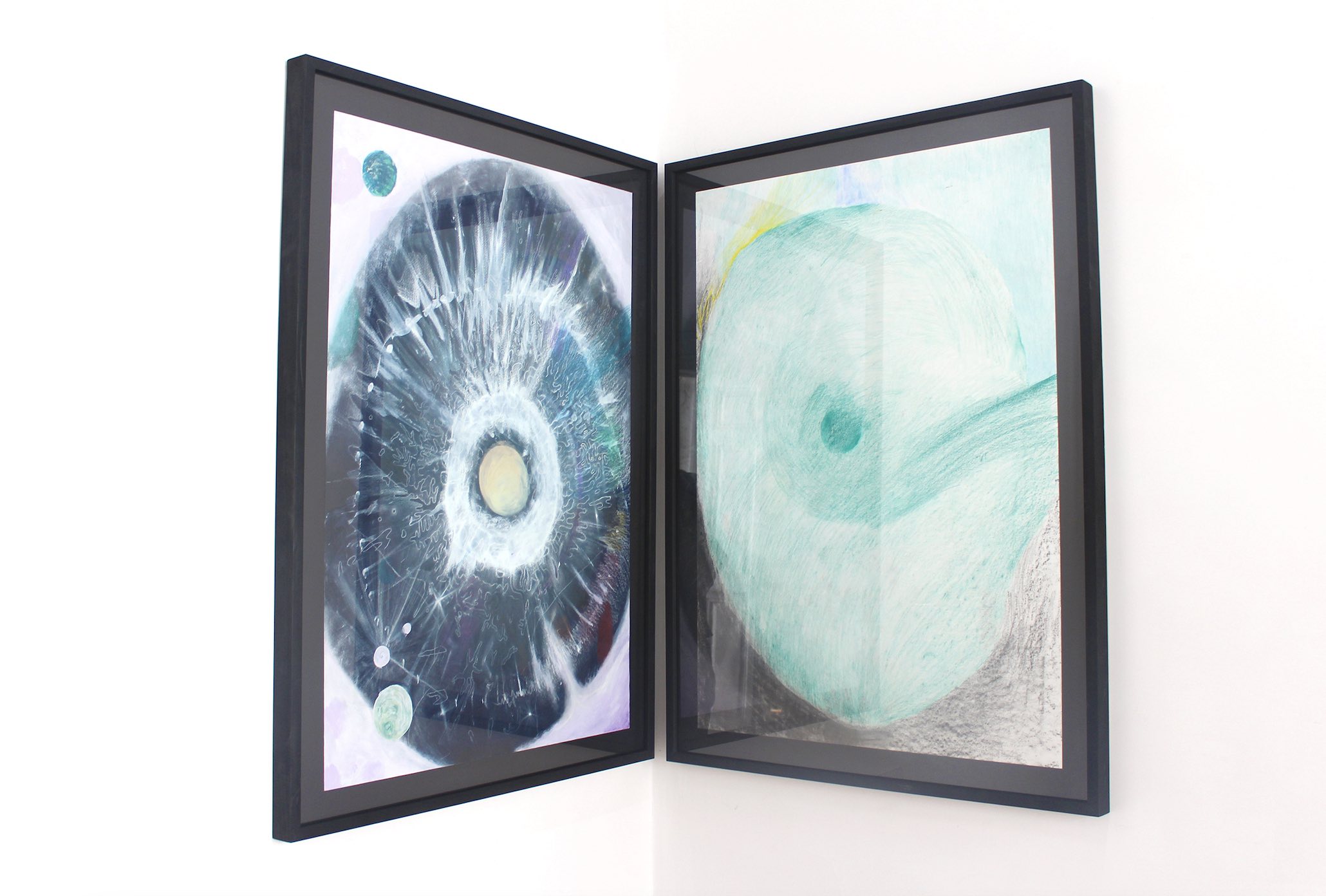
In the middle of the main room, in front of the large work, there is a suspended birdcage, half-warped and with the door open. In the next room, diagonally from where I’m standing, there are two corner paintings. Each of them portrays a kind of primordial nucleus, an ovum-eye of Sauron: they look at me intensely. Between the cage and the nucleus I feel an electric tension, as though the entire exhibition were being gestated in their exchange. Mili still hasn’t arrived, so I ask the curator about (the “official” discourse of) the show. It’s about love, she says.
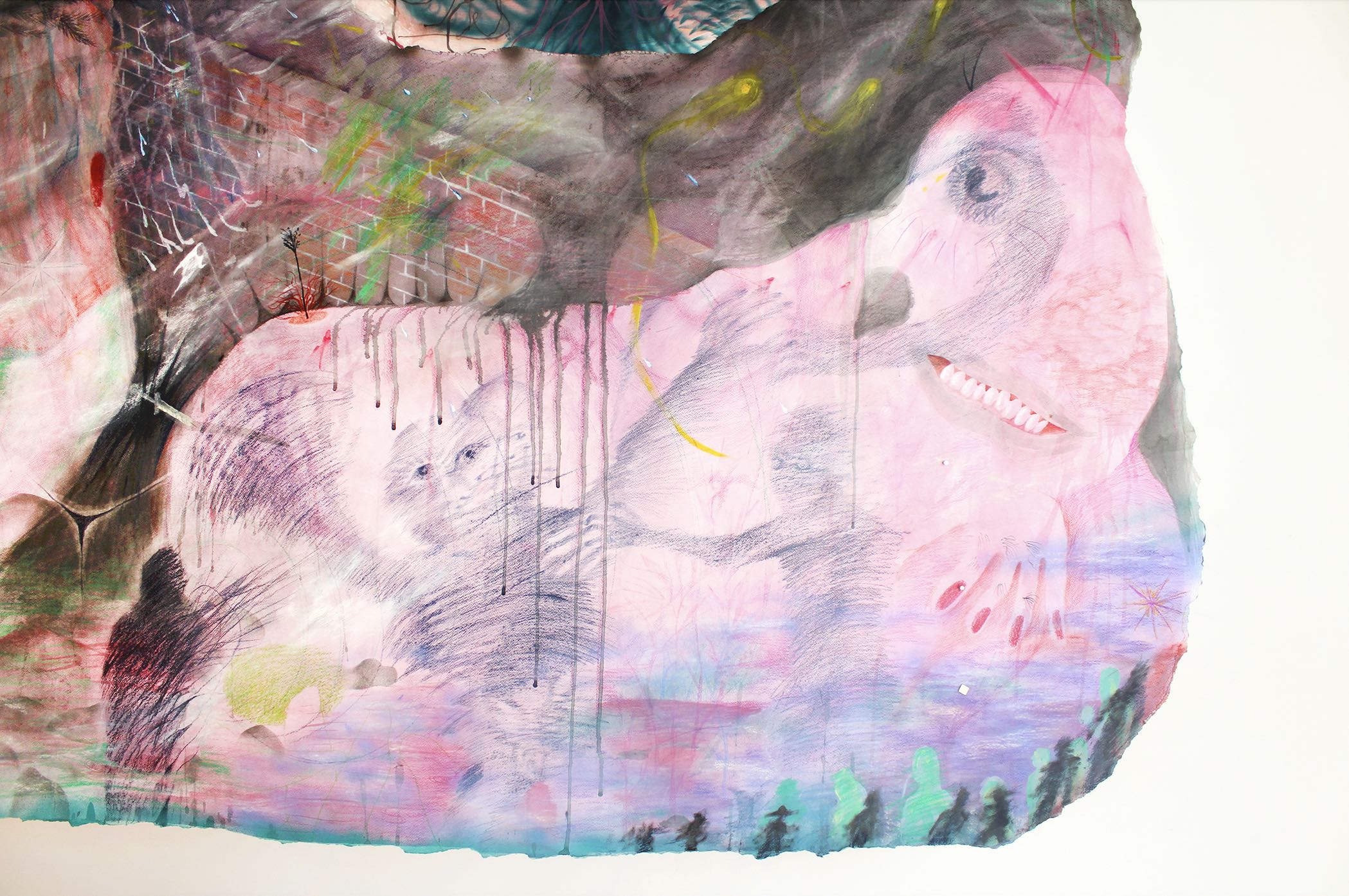
Mili arrives in a hurry and in a sweat. I have less time than I would like so we skip the foreplay and get to the work. I start with some nervous and overly general questions, but she just goes along with it. Many people have come to the show, she tells me, and she has had interesting conversations. The exhibition was born from querying a couple’s love, particularly the mourning after a breakup or death, although it has become a more general exploration of relationships between two people. It’s a theme about which we all have a lot to say. I love the confessional genre: the more explicit, the better. I think of Shakira and Piqué, and of Miley. Tender hearts everywhere.
Mili Herrera: I had experienced several kinds of grief: an important relationship had ended and later a godmother had passed away. In the mode of a couple I wanted to talk about life and death, about flesh and nerves. There’s a line from a poem by Cesar Vallejo: pobre barro pensativo (“poor, pensive clay"), referring to the body. I’m interested in the moment when the flesh begins to feel and to long for something.
The material in Mili’s work is imposed, something that is difficult to achieve in drawing. The edges of the paper are torn and frayed; there are holes and openings in the drawings behind which other planes peek out. It takes me back to the body, to the skin, to organs arranged like three-dimensional puzzles. In some of the works these are “windows”—inserted pictures—that introduce us to other worlds. She tells me that sometimes she thinks of the works as a great theater; she even draws the audience on the edges of the paper. It connects me with the sensation of simultaneity that I felt when I arrived, like a mise en scène in which all the acts are happening at the same time.
The materiality is also felt in the installation. In the second room there are several small drawings fixed to the wall with crooked pins. Another of the works is mounted with glass on both sides and shows the drawing’s worked-on back. The largest work is pierced by a large crooked arrow of rusty ironwork. When I ask her about it, she tells me that she wanted an element of real danger. I realize that if there is something in the works that makes me feel insecure, it is not the Mexican sentimentality of the broken heart receiving cantina therapy, but rather a swampy hole of adrenaline. And yet I can’t help finding happy faces and absurd smiles in the melted characters of Mili’s theater.
MH: When I started thinking about the exhibition, it was clear to me that love is creepy. Many of my works revolve around “soft horror”: terror is involved in everything, in love, politics, the body, and there’s some honesty in recognizing that. The exhibition is in that world, and yet it’s a flirtatious and mischievous horror.
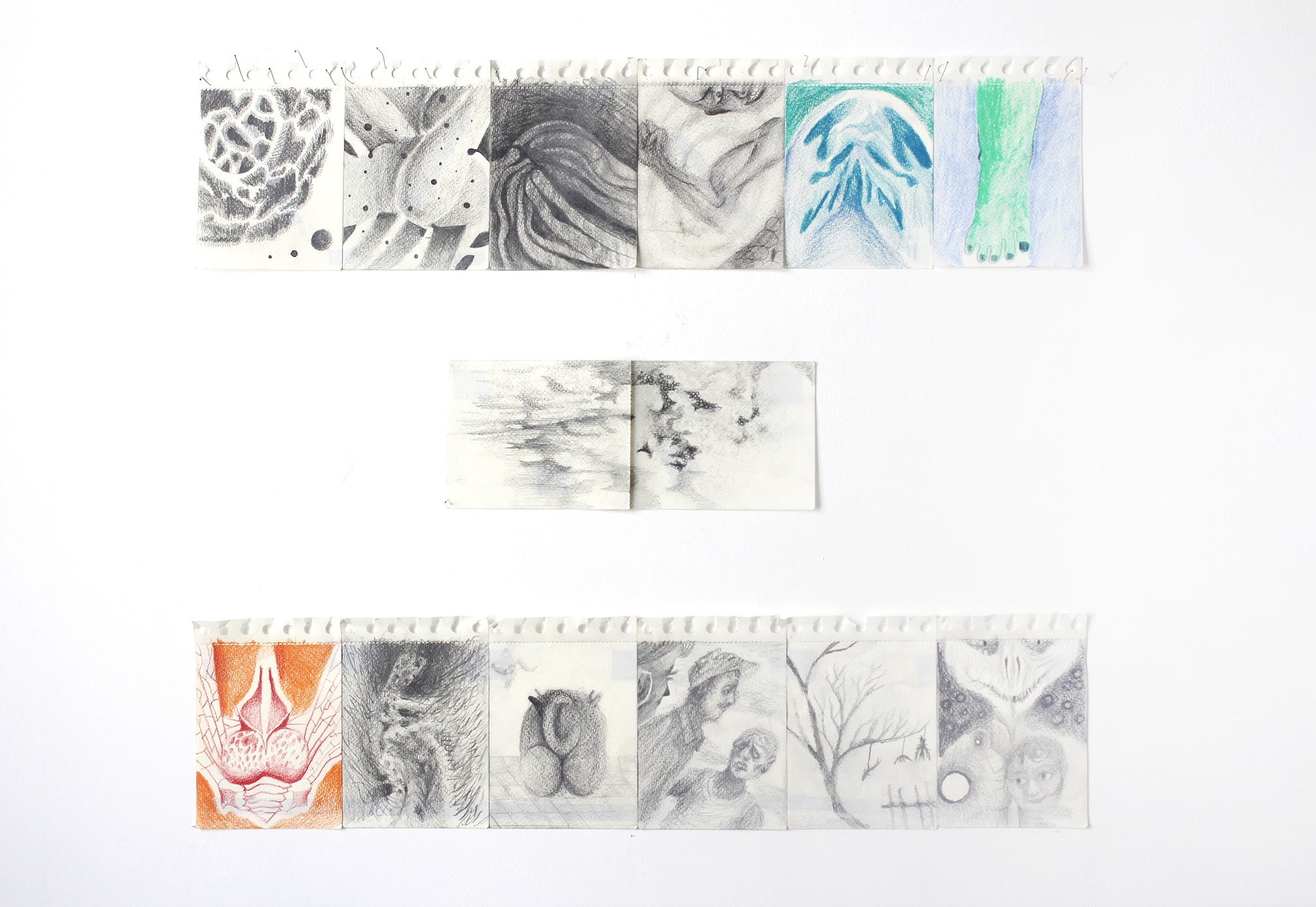
MH: As I was working, my relationship with the pieces and the theme changed. There’s a culture of its own that’s created within a relationship and when it ends it’s like a cultural apocalypse. But something remains, even though that person is no longer there: it’s a phantom nerve. Just like in the quantum physics idea where two connected atoms continue affecting each other, even though they’re a great distance away, a person can continue modifying you.
There are characters and gestures that appear over and over again: filaments between roots and nerves, feathers, insects, and erased little hands. Repetition creates a world of its own: the culture of which the artist speaks. Nevertheless, what happens when that culture is exposed to the world? In a sense it’s polluted. Mili points to the little hands surrounding several of the figure-couples, which represent the what they say. Sometimes extrinsic forces can keep two people together who maybe shouldn’t be. In any case, relationships cannot exist in isolation, like a floating island where the lovers are the only inhabitants. Intimacy is also sustained in community. I know the mother of my partner, of my friend: eventually she’ll pass me the recipe for the family carrot cake, which I will prepare for her wounded spirit in the future. The management of space reflects the ambiguity between containment and contamination. The characters and symbols exist in a dark, cosmic, and at times Cartesian world that collapses “inside” and “outside” on the same plane.
MH: At the beginning I saw this exhibition as something fateful. It felt cringe exposing a breakup to everyone’s eyes. Now I see it as something lovely. At the end of a relationship—whether it’s a question of a couple, a friendship, or a death, I need to believe that all that remains is to honor the good gestures and the memory of that person. I understood relationships and their breakups as part of a cycle. It’s a vision: I don’t know whether it’s more mature, but it’s more optimistic. I realized that the work has a lot to do with forgiveness, both towards oneself and towards the other.
She points to the feathers on the floor. I had not noticed them, but now I understand better the cage suspended in the room. In many of the pieces one can see birds with arrows or wounds. Mili tells me that the bird represents the freedom of flight: that is, each person’s individuality. The tension between the “team” that a couple forms and the individuality of each person is thus abated within this work. There are moments in which the characters run away from each other and different moments in which—in the vein of Genesis P-Orridge and Lady Jaye Breyer—they merge.* I think that ultimately the work advocates preserving an identity outside the binary; nevertheless, couples blend in all the time. People often ask me if my partner is my brother. They also tell me that I look like my dog. Perhaps it’s an impulse of the reptilian brain to survive, with a basis in the constant formation of tribes.
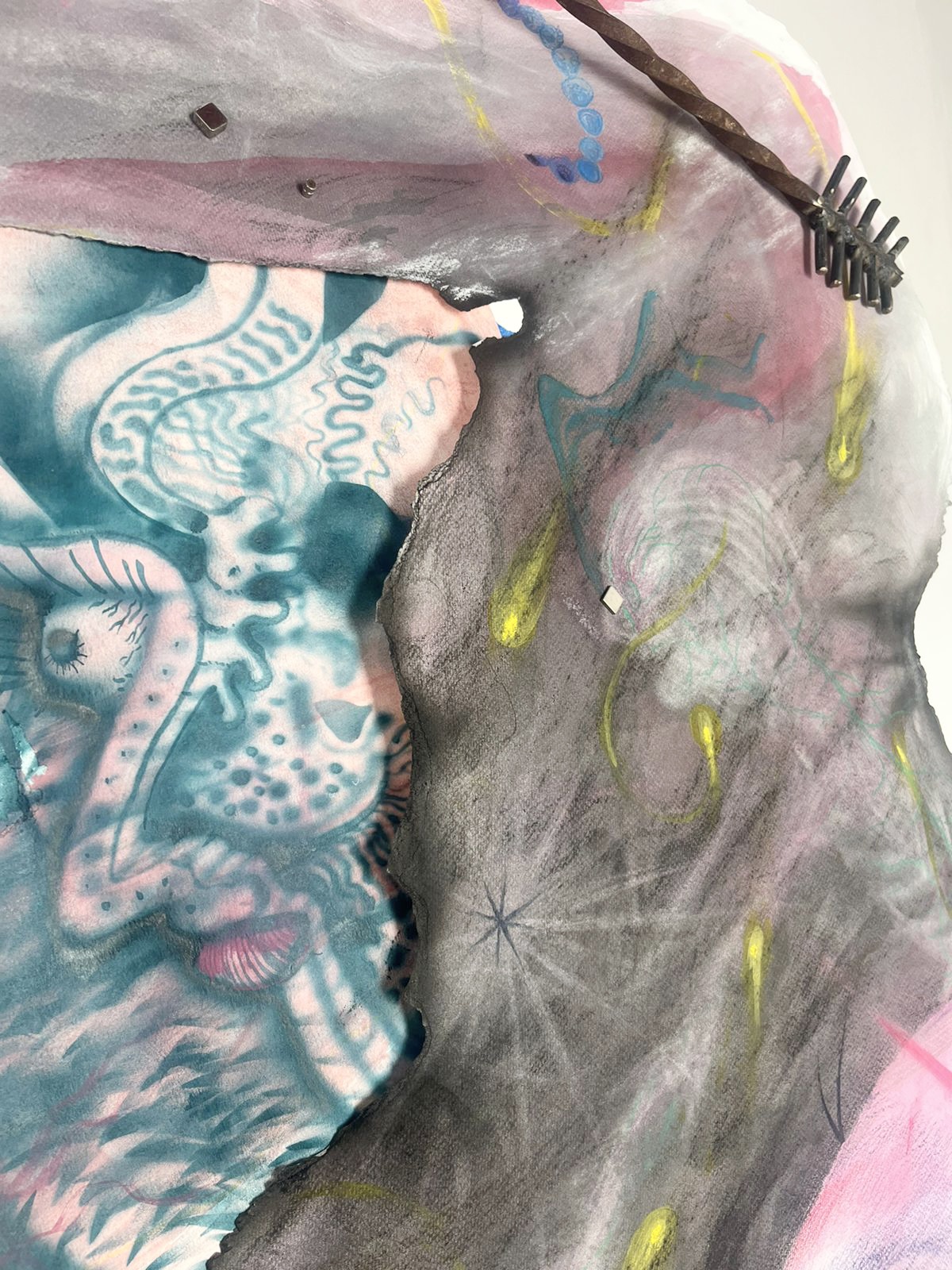
Mili tells me about a death in her family, which occurred as the exhibition was being developed, and which takes her to a place of greater generosity within her work. With a basis in that loss, she draws the primordial nuclei mentioned at the beginning of this text. These orbs are, in part, representations of the cyclical nature of relationships; a person comes into our life, sometimes they leave, though sometimes that person remains in us. Someone else arrives, and so on. These drawings by Mili are as if we were seeing our relationships from above and from far away. And in this coming-and-going of our relationships, especially within the pain of departure, we can learn to value what matters.
MH: There’s a very western and destructive way of approaching the things we want to understand: for example, if we want to know more about the platypus, we’re going to kill it and peek inside its belly to see what’s inside. I wanted to get inside that perspective of looking inward, but from another side than that of incision. There are cultures whose medicines heal from care, from caressing and surrounding a person; they heal above all from love and self-love. When I’ve come to feel dead it’s because I can’t dedicate loving time to things. Everything’s alive—it can give and receive affection if we give each other the space. One has to talk with the stones. One has to talk to everyone.
“How lovely!,” I said.
Translated to English by Byron Davies
Mili Herrera's exhibition Nervio fantasma was presented by Salón Silicón, Mexico City, from November 26, 2022 to January 12, 2023.
Published on January 30 2023